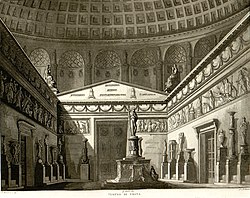LA VESTALE (Spontini) Piacenza 2024 Carmela Remigio, Daniela Pini, Bruno Taddia
In this video
LA VESTALE by Giuseppe Spontini
Teatro Municipale di Piacenza, Italy
November 24, 2024
CAST
Julia CARMELA REMIGIO
Licinius BRUNO TADDIA
Cinna JOSEPH DAHDAH
La Grande Vestale DANIELA PINI
Le Souverain Pontife ADRIANO GRAMIGNI
Le chef des Aruspices | Un consul MASSIMO PAGANO
_________________________________________________
Conductor ALESSANDRO BENIGNI
ORCHESTRA LA CORELLI
CORO DEL TEATRO MUNICIPALE DI PIACENZA
Chorus master CORRADO CASATI
_________________________________________________
Director, set and costumes GIANLUCA FALASCHI
Choreographer LUCA SILVESTRINI
Light designer EMANUELE AGLIATI
Assistant director MATTIA PALMA
Set and costumes assistant GIUDITTA VERDERIO
=================================================
La vestale (The Vestal Virgin) is an opera composed by Gaspare Spontini to a French libretto by Étienne de Jouy. It takes the form of a tragédie lyrique in three acts. It was first performed on 15 December 1807 by the Académie Impériale de Musique (Paris Opera) at the Salle Montansier and is regarded as Spontini’s masterpiece. The musical style shows the influence of Gluck and anticipates the works of Berlioz, Wagner, and French Grand opera.
Composition history
Spontini had finished La vestale by the summer of 1805 but had faced opposition from leading members of the Opéra and rivalry from fellow composers. The premiere was made possible with the help of Spontini’s patron, the Empress Joséphine, but only after being rearranged by Jean-Baptiste Rey and Louis-Luc Loiseau de Persuis. La vestale was an enormous success, enjoying over two hundred performances by 1830.
Its fame soon spread abroad; it appeared in Naples and in Vienna in 1811. The full piano score with lyrics in French and German was sold in Germany in 1812, as well as the score for an aria and a duet. In 1814 the opera was performed in Budapest followed by Stockholm in 1823. It was premiered in the United States in French at Théâtre d’Orléans in New Orleans on 17 February 1828 Wagner conducted the work in Dresden in 1844 with Wilhelmine Schröder-Devrient
Synopsis

- Place: Rome
- About 269 BC
Act 1
Returning to Rome after a victorious campaign, Licinius finds his beloved Julia has become a priestess of Vesta. Although Julia attempts to avoid going to Licinius’s triumph, she is delegated to present him with a wreath. He tells her that he intends to kidnap and reclaim her.
Act 2
In the temple of Vesta, Julia guards the eternal flame and prays to be freed of temptation. Licinius arrives; during their rapturous reconciliation, the flame expires. Licinius is advised by Cinna to flee. Julia is interrogated by the high priest but refuses to name Licinius. She is sentenced to death for licentiousness.
Act 3

Despite the pleas of Licinius, Julia is to be buried alive; even when he admits his intrusion to the Temple, Julia claims not to recognise him. A thunderstorm ensues, during which lightning reignites the sacred flame. Recognising this as a sign from the Gods, the High Priest and Vestal Priestess release Julia who is then married to Licinius.
Quoted from Wikipedia
